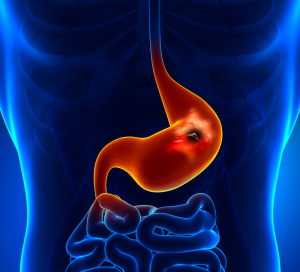Introduction
Stomach cancer pain can present as epigastric abdominal pain. Another term for stomach cancer is “gastric cancer” (the medical term). This cancer is very common in Japan, Iceland and Chile, where it is one of the most common causes of death. In the U.S. it is the 7th most common cause of death and occurs at a rate of about 8 new cases per 100,000 population per year. It can develop out of polyps that develop inside the lining of the stomach.
But it may develop in a chronic gastric ulcer. The bacterium Helicobacter pylori (=H. pylori) is often the reason why a gastric ulcer is chronic.
Symptoms
Often there are no symptoms in the beginning of the disease, although subtle symptoms may be present and overlooked. For instance, a feeling of fullness after a full meal may point to a stomach cancer developing in the gastric outlet. Swallowing problems (=dysphagia) due to a stomach cancer at the entrance of the stomach should trigger the physician to arrange for an endoscopy of the patient by a gastroenterologist or surgeon.
Weight loss is a cardinal sign of cancer, but particularly of stomach cancer and needs to be taken extremely serious. Of course, there are always other causes such as depression or diabetes, but a good start is to see your physician to have things checked out. There might be a lassitude because of a chronic blood loss from a chronically bleeding ulcer that has degenerated at the margins into stomach cancer. This blood loss is often the reason for iron deficiency anemia.
Late signs of stomach cancer are a palpable mass in the epigastric area, epigastric pain from local or liver metastases or other distant metastases ( brain, lungs, bones).
With liver involvement there would be jaundice and ascites. Because of the unreliability of history and symptoms, diagnostic tests such as routine endoscopy of high risk populations has been tested particularly in Japan, where the stomach cancer rates are higher. Endoscopy with biopsy of suspicious lesions and double contrast stomach X-ray studies have found stomach cancers much earlier, when therapy can make a positive difference.
Treatment
Stomach surgery is the treatment of choice. The surgeon should see the patient as early as possible. In the cases of Malt lymphoma (=gastric lymphoma), which is another form of stomach cancer, the physician uses a combination chemotherapy and radiotherapy, often with better long-term prognosis than an adenocarcinoma.
For a more detailed description of stomach cancer click on this link.
References
1. DM Thompson: The 46th Annual St. Paul’s Hospital CME Conference for Primary Physicians, Nov. 14-17, 2000, Vancouver/B.C./Canada
2. C Ritenbaugh Curr Oncol Rep 2000 May 2(3): 225-233.
3. PA Totten et al. J Infect Dis 2001 Jan 183(2): 269-276.
4. M Ohkawa et al. Br J Urol 1993 Dec 72(6):918-921.
5. Textbook of Primary Care Medicine, 3rd ed., Copyright © 2001 Mosby, Inc., pages 976-983: “Chapter 107 – Acute Abdomen and Common Surgical Abdominal Problems”.
6. Marx: Rosen’s Emergency Medicine: Concepts and Clinical Practice, 5th ed., Copyright © 2002 Mosby, Inc. , p. 185:”Abdominal pain”.
7. Feldman: Sleisenger & Fordtran’s Gastrointestinal and Liver Disease, 7th ed., Copyright © 2002 Elsevier, p. 71: “Chapter 4 – Abdominal Pain, Including the Acute Abdomen”.
8. Ferri: Ferri’s Clinical Advisor: Instant Diagnosis and Treatment, 2004 ed., Copyright © 2004 Mosby, Inc.







